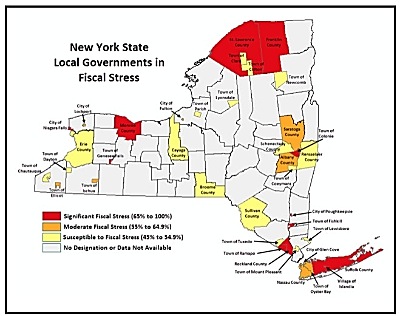- By -Staff
- News
 Print
Print  Fourteen local governments, including Rockland, Suffolk, Nassau and Erie counties, have been designated as fiscally stressed in the latest update of State Comptroller Thomas P. DiNapoli’s Fiscal Stress Monitoring System. The update was issued in conjunction with a report highlighting the similarities among localities listed in fiscal stress.
Fourteen local governments, including Rockland, Suffolk, Nassau and Erie counties, have been designated as fiscally stressed in the latest update of State Comptroller Thomas P. DiNapoli’s Fiscal Stress Monitoring System. The update was issued in conjunction with a report highlighting the similarities among localities listed in fiscal stress.“The increased number of municipalities in fiscal stress underscores the seriousness of the challenges facing local governments,” said DiNapoli. “By shining a light on the financial issues confronting our municipalities, we can jumpstart discussions at the state and local levels about fiscal stress so that corrective actions can be taken. There is a continued need for better long-range planning and honest conversations about how local governments operate when their regional economies, demographics and traditional revenue sources change.”
This update is a follow-up to the release of the monitoring system’s initial scores in June and provides a designation for 88 local governments that either had not filed the necessary financial information with the Comptroller’s office or were previously listed as “under review.”
Of the fiscal scores released today, the following local governments are in the highest category of fiscal stress: Rockland, Suffolk, and St. Lawrence counties, the city of Poughkeepsie, the town of Fishkill and the village of Islandia.

DiNapoli’s monitoring system evaluates local governments on 23 financial and environmental indicators. Indicators include cash-on-hand and patterns of operating deficits, together with broader demographic information like population trends and tax assessment growth. The financial indicators are used to create an overall fiscal stress score and classify whether a community is in “significant fiscal stress,” “moderate fiscal stress,” “susceptible to fiscal stress,” or “no designation.”
The communities newly designated as in “moderate fiscal stress” were: Nassau County, the town of Oyster Bay and the city of Lockport. Erie and Schenectady counties and the towns of Tuxedo, Coeymans and Parish were designated as “susceptible to fiscal stress.”
Overall, the system has identified a total of 38 communities in some level of fiscal stress. The list now includes 14 counties, 18 towns, five cities and one village.
The fiscal stress scores are based on financial information provided to DiNapoli’s office by local communities as of Aug. 30, 2013 and included only municipalities with fiscal years ending on Dec. 31, 2012. In New York, all 932 towns, 57 counties, 44 cities and 10 villages have a Dec. 31 fiscal year end – a total of 1,043 communities.
Of these local governments, 54 municipalities still have yet to submit necessary financial information to the Comptroller’s office and are designated as “have not filed.” There are 948 communities that have been classified as “no designation.” DiNapoli also said three communities remain “under review” and continue to have their information vetted.
According to a report issued today as part of the fiscal monitoring system update, nearly 25 percent of all counties and 11 percent of cities were fiscally stressed compared to only 2 percent of towns.
DiNapoli said that all localities found to be in fiscal stress share a number of common characteristics. This includes low fund balance, a continued pattern of operating deficits and inadequate cash on hand to pay their bills.
Additionally:
- More than a third of fiscally stressed communities regularly issue short-term debt to fund operations;
- The median county had enough cash on hand to cover only 1.5 months worth of expenses while the median stressed county did not have enough to cover even one month’s worth of expenses; and
- The median city had an unassigned fund balance of 7.9 percent of expenditures while the median stressed city had a negative unassigned fund balance.
The report also noted that fiscally stressed municipalities are also confronting significant environmental challenges including increasing poverty, decreased state and federal funding, loss of jobs, declining property values and population loss.
Later this year, DiNapoli’s office will release a separate scoring list for school districts and those cities and villages whose fiscal years end at various periods throughout the year.
v9i36



